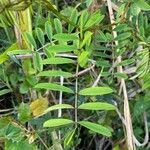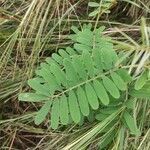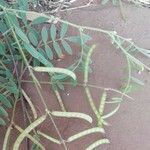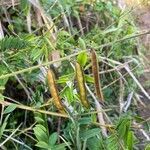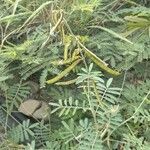Herbs, perennial, suffrutescent, 0.5-1.5 m tall. Stems terete, with dense spreading trichomes. Stipules narrowly triangular, 6-11 mm, persistent, apex acuminate. Leaves 15-25-foliolate; rachis 7-11 cm, including petiole 0.7-1.3 cm; leaflet blades oblong-oblanceolate, 2.2-3.2 × 0.5-0.8 cm with terminal one slightly larger than others, abaxially densely appressed sericeous, adaxially glabrous, secondary veins 9-11 on each side of midvein, base cuneate, apex rounded to retuse and cuspidate. Pseudoracemes terminal, 15-25 cm, rigid and straight, with scattered flowers. Pedicel 2-4 mm. Flowers ca. 1 cm. Calyx ca. 5 × 5 mm, densely brown pubescent; teeth unequal, most abaxial one 4-6 mm and narrow, other ones short and broad. Corolla yellow, violet, or white; standard orbicular, brown sericeous. Ovary sericeous, with numerous ovules. Legume linear, 4.5-5 cm × ca. 5 mm, straight, densely brown pubescent, apex ascending curved. Seeds 7-9 per legume, black, reniform, ca. 4 × 2.5 mm, usually transversely rugose. Fl. and fr. Nov-Jan. 2n = 22.
